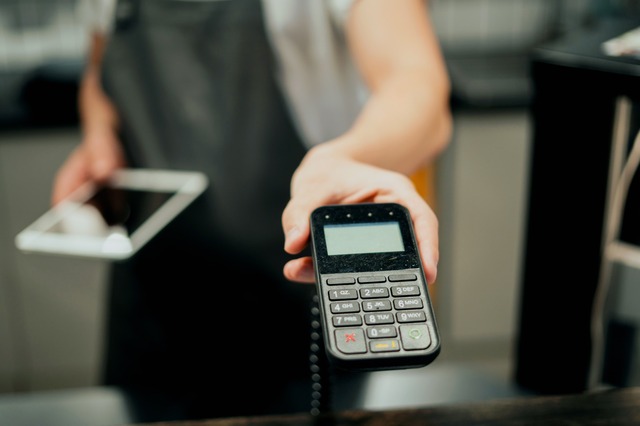Contactless payment, or tap-and-go transactions, allow consumers to make purchases without having to swipe a card. Consumers simply bring their contactless card or mobile wallet near a compatible point-of-sale (POS) terminal to complete the transaction.
This process is more secure than magnetic stripe credit cards because it doesn’t transmit unencrypted information. This reduces the risk of hacking and identity theft.
NFC technology
NFC technology combines two different building blocks – Radio Frequency Identification (RFID) and Near Field Communication (NFC). RFID enables the interaction between an active device like a payment terminal or a smartphone and a passive tag. NFC protocols and standards, developed by the NFC Forum, then ensure that devices can actually communicate with each other.
Using NFC, customers can make contactless payments by tapping their NFC-enabled devices like smartphones or wearables against a terminal. This eliminates the need to swipe or insert a card physically, and it speeds up the overall transaction time.
NFC can also be used to transfer data between devices, such as music files, photos or contact lists. Skilled hackers could potentially use this technology to hack into a device or “digitally pickpocket” a user from close range, but it’s not an easy task. NFC communication works over short distances, usually a few centimeters, and transmits data unencrypted. This makes NFC less secure than Bluetooth and WIFI, but it is still more secure than physical credit cards.

Tap-and-go transactions
Contactless payments use NFC (Near-Field-Communication) chip technology that sends encrypted data over radio waves to NFC-enabled card readers. Customers can use this technology to make contactless purchases with a mobile wallet or card linked to their phone or bank account. The process is faster than scanning a magnetic stripe or entering a PIN number, and the transactions are secure.
When a customer places their card or device within a few inches of the payment terminal, an NFC-enabled payment system reads the information on the chip and transfers it to the terminal in seconds. The transaction is completed when the payment terminal emits a beep or displays a green light.
While every payment method carries some risk, such as losing cash or hackers duplicating mag-stripe cards, contactless payments provide the most security and convenience of all payment methods. And since they’re much more speedy than traditional transactions, customers can get out of your store or restaurant faster.
Mobile payments
As consumers continue to embrace E-wallets, mobile contactless payments have gained traction. Consumers can make purchases using their credit cards stored in a payment app on their smartphone or mobile device, which transmits the transaction details to a compatible card reader via near-field communication (NFC) technology.
This type of payment is quick and convenient, as consumers don’t have to dig out their wallets or enter a PIN. Mobile payments can also be made at off-site events like fundraisers, trade shows, or even in physical stores that don’t have NFC terminals.
NFC mobile payments use a security feature called tokenization, which helps protect the customer’s financial information. Tokenization creates a unique code for each transaction, so there’s no way for a customer to accidentally pay twice for the same purchase. Additionally, POS terminals that support NFC mobile payments will only communicate with one card at a time — not multiple cards that are nearby. A card or device must be within 10 centimeters of the NFC reader to initiate a tap-and-go transaction.
Security
Contactless payments offer greater security than traditional cards with a magnetic stripe, with encrypted systems to transmit data that protects consumers and merchants from scammers. These systems include EMV chips in contactless credit cards that send unique codes instead of card numbers to POS terminals, which makes it harder for fraudsters to intercept and use this information. Other technologies, like tokenization, replace sensitive cardholder data with unique tokens that are used only once and can’t be reconstructed.
Additionally, the proximity of the card or device to a terminal — a mere inches in most cases — means that skimming is less of a risk. This, combined with many card issuers’ zero-liability policies and two-factor authentication, helps to reduce the potential for fraudulent transactions.